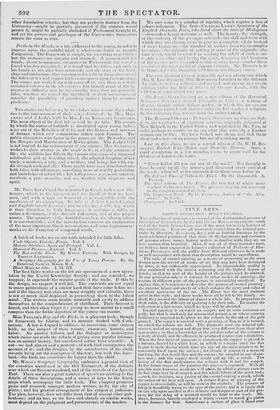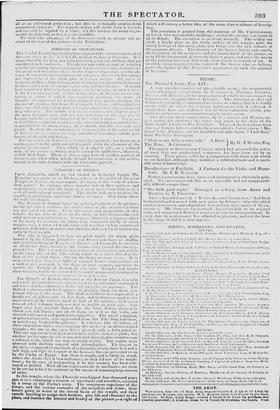FINE ART S.
itacristt 'Ns:Tat-mix : toe.: 1;a4 Examus.
Tim collection of miniatures in enamel of the distinguished persons of
the reign of Emz.l.nETII, by the kite I leylty Bost:, occupying the south
earl of the South Boom, ferms one the most interesting features of
this ethibithat. '1 buy all accurately copied front the original por- traits by 1101.11EIN, ZUCCHEHO, &v. ; and as faithful limnings by the most celebrated painters of that time of the lineaments and costumes of persons whose names history makes its familiar with, they are no less curious than beautiful. Alost, it' not all of these portraits have, we believe, been engraved au Loncr.'s collection of Portraits of Illus- trious Personages, and the public have albs and otherwise been made so well acquainted with them that description would be superfluous.
The value of enamel palming, as a means of preserving to the most
distant ages the record of works of art that may have been destroyed by time, is not sufficiently appreciated. Its imperishable quality is also combined with the richest colouring and the highest degree of finish ; so that no part of the beauty of the picture need be omitted. In one particular only is it inferior to other modes of painting—the- texture of different parts of the picture is unavoidably sacrificed. To explain this, it is requisite to describe the process of enamel painting; the extreme labour and nicety of which enhance the rarity and value of excellent specimens of the art. Mr. BONE was the most eminent artist in this style ; and these works were all he left to his family : in- deed, they formed the labour of almost a whole life. In proportion to their value, is the diffieulty of realizing it by their sale. To scatter the collection is a last resort, which we hope will be obviated.
Enamel painting is executed on copper, and in some instances on
gold; but that is used only for ornamental purposes, or where extreme brilliancy is required to be given to the colours by the aid of the gold ground. The copper is covered with a priming, or flux, as it is termed, on which the colours are laid. The pigments used are mineral sub- stances, and of an opaque and dingy hue, very different from their after appearance ; so that D knowledge of the relative value of the colours is u study of itself, and the effects to be produced require nice calculation. When the first layer of pigments is completed, the copper is placed in a furnace, heated to a white heat, in which it remains until the flux begins to melt, during which time the eye of the artist requires to be constantly fixed upon the surface ; for should it remain in a moment too long, the flux would flow and the colours be mingled in one shape- less mass, and the copper itself would roll up like a scroll. The fusing of the Aux amalgamates the colours with it and the copper. In the future stages of the palming this process is repeated. With all possible care, however, accidents oil (incur, by which a picture even in its last stage may be destroyed, and the whole labour of the artist lost; —such, for instance, as a jarring of' the enamel causing a crack, which the action of the heat will open. A certain degree of warping of the copper is unavoidable, as will be seen in the enamels. The process of tiring is dreadfully trying to the eyes of' the artist; and it is rarely that he can rely upon another in this delicate and dangerous part of the pro- ceas, for the delay of a moment would be fatal to the work. Mr. BONE, however, latterly employed a trusty servant to watchLlte plates in the furnace for him. Sometimes a surface of glass is lased over
all us an additional protection ; but this is orint•ipally employed for ornamental purposes. The enamel surface will resist even a scratch, and can only be injured by a Wow ; tl.e flux renders the metal inq.er- meablc to moisture, so that it is ineortodible.
We shall take advantage of the first open week to resume our ac- count of the rest of the pictures in the Exhibition.



























 Previous page
Previous page